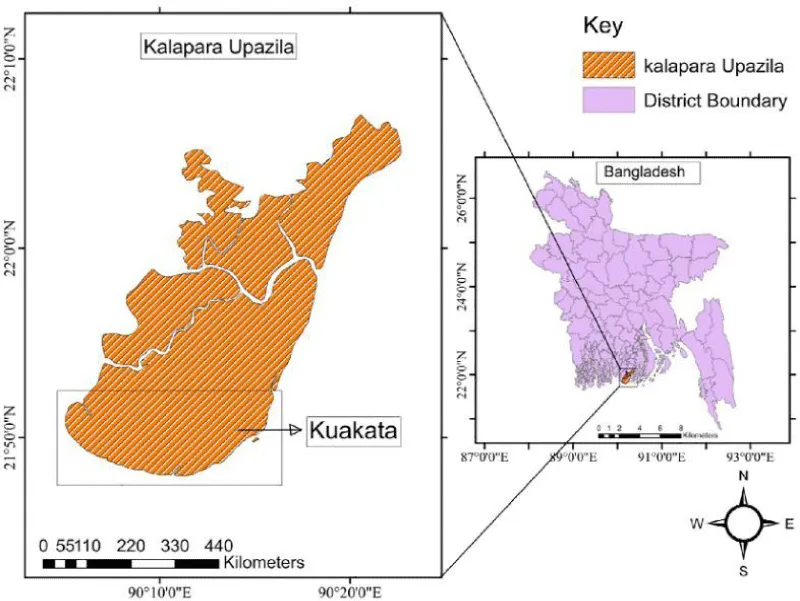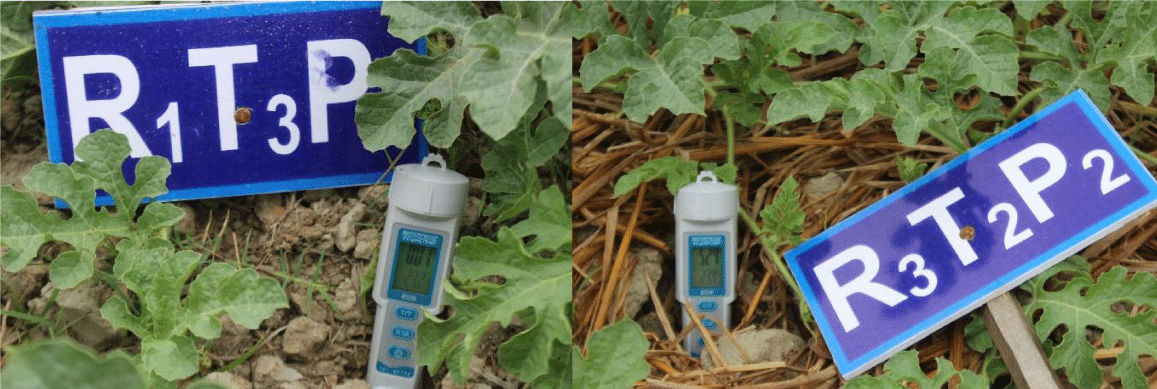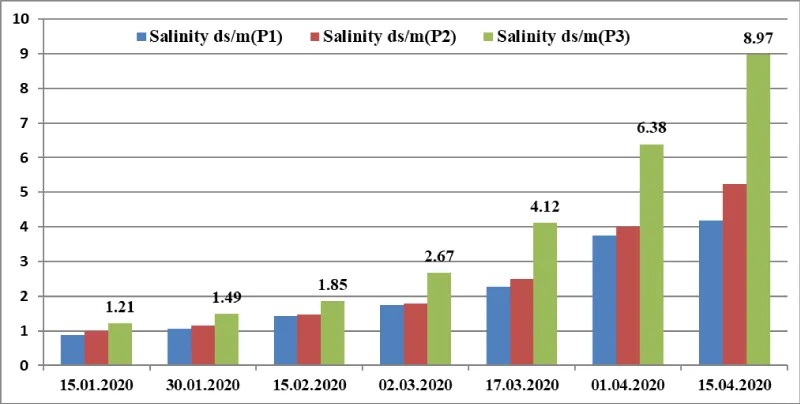International Journal of Agricultural Science and Food Technology
Fertilizer doses and mulching effect to mitigate soil salinity and maximize yield of watermelon (Citrullus lanatus L.) in coastal region of Bangladesh
Md. Mainul Islam1*, Md. Mahmudul Hasan Khan2*, Md. Shahidul Islam Khan3, Gazi Nazmul Hasan4, Nasira Akter5, Krisna Chandra Saha6, Md. Torikul Islam7 and Md. Rashidul Hasan Anik8
2Plant breeder, Oilseed and Legume crops, Oilseed Research Center, Bangladesh Agricultural Research Institute, RARS, Barishal-8211, Bangladesh
4,8On-farm research division (OFRD), Bangladesh Agricultural Research Institute (BARI), Bhola-8300, Bangladesh
5Plant breeder, Regional Horticulture Research Station, Dumki, Patuakhali-8602, Bangladesh
6Plant breeder, Oilseed Research Center, Bangladesh Agricultural Research Institute, Gazipur-1701, Bangladesh
7Horticulturist, Horticulture Research Center, Bangladesh Agricultural Research Institute, Gazipur-1701, Bangladesh
Cite this as
Islam MM, Khan MMH, Khan MSI, Hasan GN, Akter N, et al. (2023) Fertilizer doses and mulching effect to mitigate soil salinity and maximize yield of watermelon (Citrullus lanatus L.) in coastal region of Bangladesh. Int J Agric Sc Food Technol 9(4): 093-097. DOI: 10.17352/2455-815X.000198Copyright License
© 2023 Islam MM, et al. This is an open-access article distributed under the terms of the Creative Commons Attribution License, which permits unrestricted use, distribution, and reproduction in any medium, provided the original author and source are credited.An experiment was conducted in the rabi season at Patuakhali, Bangladesh to verify the effect of different mulching materials for watermelon production under farmers field condition. The aim of this research was to test the possibility of salinity damage can be reduced by elevating potassium (K) fertilization rate on watermelon yield and nutrient uptake under salt stress condition. Four different fertilizer doses T3 = Soil Test Based (STB), T2 = STB + 50% K, T3 = Integrated Plant Nutrients System (IPNS) approach with 5 tonha-1 cowdung (CD) + 50% K and T4 = Farmers practices with many materials usedP1 = Silver color polythene mulch, P2 = Straw mulch, P3 = No mulch combination. Twenty days old seedling were used in farmers’ field. Other nutrients were also applied following STB method. Fertilizer used as the rates of N117P30K30S25 (T1), N117P30K37S25 (T2), N92P22.5K45S25 with 5 tonha-1cowdung (T3) and N100P40K35S30 (T4). All the plant growth, yield and quality characters were superior in T3 with silver polythene (31.96 tonha-1) while plants without mulch and STB method resulted poor growth and yield of 24.31 tonha-1. The higher rates of K contributed to 7- 27% increased yield over only STB dose for Patuakhali which implies the necessity of higher dose of K in salt affected soil in strengthening yield. With economic point of view, T3 (IPNS with 5 ton/ha cowdung + 50% K and silver polythene mulch) seedling reported the highest net return of 375780 Bd TK and found more economical with highest cost benefit ratio.
Introduction
In the southern region, huge land remains fallow in the rabi season after harvest of T. Aman rice. Among these, a significant part is medium highland, and the area would be about 50% of the total fallow land, where watermelon can be grown without competition or with a less competition with Rabi crops [1]. The cultivable areas in coastal districts are affected with varying degrees of salinity [2]. After T. Aman rice harvest land become dry crop establishment become very difficult. So, to find out a way to crop establishment polybag seedling transplantation an alternative [3]. In this way, a huge fallow land in the rabi season could bring under cultivation, so that socio-economic condition of the farmers would be changed [3].
Salinity is one of the most detrimental factors limiting the productivity of agricultural crops, with adverse effects on germination, plant vigor and crop yield [4]. In Bangladesh, salinization is one of the major natural hazards hampering crop production. High salt content affects the physiology of plants at the cellular and whole-plant levels [5]. Ionic imbalance occurs in cells due to excessive accumulation of Na+ and Cl- ions that reduce uptake of K+, Ca2+, and Mg2+ [6]. It is already reported that elevated amount of K (50% of recommended rate) in coastal region increase yield [7]. In coastal region of Bangladesh salinity were higher in the month of March and April. Potassium is associated with the movement of water, nutrients, and carbohydrates in plant tissue. It’s involved with enzyme activation within the plant, which affects protein, starch, and Adenosine Triphosphate (ATP) production [8]. The production of ATP can regulate the rate of photosynthesis [9]. Additionally, potassium aids in controlling the stomata’s opening and shutting, which controls the exchange of oxygen, carbon dioxide, and water vapor [10]. Plant development is stunted, and yield is decreased if K is insufficient or not provided in sufficient proportions [11]. The influence of soil temperature on plant growth is related to the fact that warmth promotes crop development through increased water and nutrient uptake, while cold inhibits water uptake due to lower water viscosity and slows down the process of photosynthesis [9,12].
Watermelon is one of the most growing crops in southern coastal region. After T. Aman rice harvest, it is cultivated as a cash crop. According to DAE-2020, Patuakhali report, watermelon production during 2017-2018 at Patuakhali district was 13350 ha. Most of the times watermelon production seriously hampered by early rainfall in March and higher salinity [13]. During 2015 - 2016 rain destroyed most of the watermelon in coastal region. So, watermelon is a very risky crop [14]. To produce watermelon, farmers usually sow the seeds directly in the field at in January after T. Aman rice harvest that greatly affected by rain or hailstorm during March [15]. It is reported that this situation could be overcome by early planting of seedling which may help to early harvest, escape hail storming loss and to get higher market price. Considering the above incidence, this experiment was carried out in Kuakata, Patuakhali, to confirm the impact of various mulch materials on watermelon production under farmers’ field conditions. The goals were to investigate the effects of mulch material and Potassium (K) fertilization interactions on watermelon yield and nutrient absorption under salt stress conditions, as well as to test the hypothesis that salinity damage might be mitigated by increasing K fertilization rate. Moreover, this finding will be beneficial to the researchers and the grower to improve the production of this crop under slain prone as well as costal region.
Materials and methods
During the 2019 – 2020 rabi season, an experiment was carried out in Kuakata, Patuakhali (Figure 1), to confirm the impact of various fertilizer dosages with mulch materials on watermelon production under farmers’ field conditions. Table 1 is a list of the weather data during the farming season. Four different fertilizer doses T1 = Soil Test Based (STB), T2 = STB + 25% K, T3 = IPNS approach with 5 tha-1 CD + 50% K and T4-Farmers practices with mulch materials used P1 = Silver color polythene mulch, P2 = Straw mulch, P3 = No mulch combination. The treatment combination was shown in Table 2. Twenty days old polybag seedling were used in farmer’s field. The experiment was laid out in RCB design with three compact replications having unit plot size 6 m x 5 m. Seeds were sown on 16 January 2020 and harvested started on 15 April 2020. Initial soil nutrient status of experimental site was shown in Table 3 and Figure 2. Standard cultural practices were done as and when necessary. Data were collected plot wise and analyzed statistically in open-source software R.
Result and discussion
Soil temperature
Soil temperature play important role to plant growth and seedling estabilishments. In the polythene, straw, and without mulch soil and air temperatures were recorded at ten altenative day during transplanting to harvesting dated. Over the sampling date soil temperature in polythene mulch treatment ranged from 22.3 °C to 38.5 °C. In the case of straw mulch from 21.4 °C to 34.2 °C but without mulch soil temperature soil temperature range varies 21.4 - 31.1 (Table 4). It indicated that under mulch treatment soil temperature fluctuated more compared to without mulch treatment. The mean temperature of soil in polythene mulch, straw mulch and nomulch treatment was 30.97, 28.1 and 26.15 °C, respectively. Thus, the results clearly evidenced that use of silver polythene mulch can increase soil temperature by 4.82 °C. The air temperature was found 1 °C to 2 °C lower than the soil temperature during the entire data recording periods with mean of 24.5 °C. Kafkafi, [16] and Aragüés, et al. [17] reported that mulches accelerate crop development in cool climates by increasing soil temperature.
Effect of elevated levels of Potassium with different fertilizer doses
The soil was clay and slightly acidic. However, the values of N, P and K were below the critical values of the nutrients in the soil of Patuakhali district, these relatively low level of major nutrients signify the need for augmentation to enhance the optimal performance of watermelon production [14]. The variety Jaguar Jumbos plants per plot were affected by different rates of fertilizers. The excessive level of K application in salt affected soil mostly maximized the yield of watermelon. The fruit yield further increased with the increasing dose K where the highest yield (31.61 tha-1) was recorded with 50% excess K doses with IPNS with 5 ton/ha cowdung, which was statistically similar to 30% excess doses of STB K but significantly higher over rest of the K doses (Table 5). The higher rates of K contributed to 7% - 27% increased yield from soil test-based doses. The highest plants per plot (17.44) were obtained from IPNS with 5 t/ha cowdung + 50% K ie. T1 Treatments where 50% excess K doses were used. The resulted treatment fertilizer doses wereN92P22.5K45S25 with 5 t/ha cow dung. From above observation higher dose of K accelerate significant variation for Vine length, number of fruits per plant, individual fruit weight. The highest vine length (275.11), number of fruits per plant (17.79) and individual fruits weight (6.28) obtained from this treatment (T3). As a result, the highest yield (31.61) obtained from these treatments. Excess rates of K application in salt affected soil increased the yield and yield contributing character of watermelon and reducing the Na: K ratio in plant tissue. The lowest yield (24.85) was observed in treatment T1 (N117P30K30S25).
Effect of mulching
The result showed that different types of mulching material significantly influenced the growth parameters of watermelon viz- Plants per plot, Vine length, Number of fruits per plan and Individual fruit weight over control. Among different mulching treatments, treatment (P1) silver polythene mulch resulted higher Plants per plot (17.25), Vine length (265.42), Number of fruits per pit (1.77) and Individual fruit weight (5.54) (Table 6). The increase in growth parameters was attributed to sufficient soil moisture near root zone, increasing soil temperature, minimize soil salinity (Figure 3) and minimized the evaporation loss due to mulching. The extended retention of moisture and availability of moisture also leading to higher uptake of nutrient for proper growth and development of plants, resulted higher growth of plant as compared to control. It was found that all the treatment of mulching material was significantly increased the fruit yield of watermelon. A similar statement was reported by Khalil, et al. [18]. Among all mulching treatments, maximum fruit yield (27.98 t/ha) recorded in treatment (P1) silver mulch which was higher as compared to other mulch. The lowest yield (25.33 t/ha) were observed in without mulch condition.
Interaction effect of fertilizer and polythene mulch
The significance different observed Plants per plot, Vine length, Number of fruits per plan and individual fruit weight and fruit yield due to interaction effect of fertilizer doses and mulches (Table 7). The highest plants per plot was observed in T3P1 (18.67) which was statistically identical T2P1 (18.00) and T3P2 (17.33). The lowest plants per plot (13.33) was observed in T3P4 treatments. The highest vine length was observed in T3P1 (282.33cm) which was statistically identical T3P2 (275.67) and T2P1 (263.00). Number of fruits per pit was observed in T3P1 (1.89) which was statistically similar to T3P2 (1.84). The maximum fruit yield was observed in T3P1 (31.96) treatment because of all its yield boosting character were higher. Treatment combinations having IPNS with 5 t/ha cowdund + 50% K and mulches (polythene or straw) might have conserved soil moisture for longer period and thus reducedsoil salinity to some extent that favored better growth and yield. In terms of economics, IPNS with 5 tons/ha of cowdung with 50% K and silver polythene mulch seedling had the greatest net return (375780 tk) and was shown to be more cost-effective with the highest cost-benefit ratio (2.88) (Table 8). This findingis in agreement with Muromota, et al. [19] and Mahmood, et al. [20].
Conclusion
Production of high value crops in the coastal saline areas particularly during Rabi season (dry season) is very limited due to rise in soil salinity. The maximum amount of fertilizer dosage that can be increased while reducing the increase in soil salinity and promoting crop growth. From this study it was revealed that, fertilizer doses and mulching both minimizes rise in soil salinity significantly. Besides, use of cowdung and extra amount of potassium (K) with recommended fertilizers along with mulching helps to reduce soil salinity and increased crop yield.
Authors’ contributions
Md. Mainul Islam and Md. Shahidul Islam Khanare key personnel for the conceptualization of this article. Md. Mainul Islam and Md Mahmudul Hasan Khan were responsible for methodology, data curation, and the formal analysis. Md. Mainul Islam and Md Mahmudul Hasan Khan wrote the original draft of this paper. Gazi Nazmul Hasan, Nasira Akter, Krisna Chandra Sahaand Md. Torikul Islamr eviewed and edited the paper. All authors have read sincerely and agreed to publish a version of the manuscript.
The authors are grateful to Bangladesh Agricultural Research Institute (BARI), officer-in-charge, OFRD, and as well as all the staff of the on-farm research division, Patuakhali.
- Numan A, Khan M, Uddin R, Rahman M, Bhuiyan M, Akter N. Risk assessment of commonly used major pesticides for tomato (Solanum lycopersicum L.) cultivation in Bangladesh. Adv in NutrFd Sci: ANAFS-109. 2018.
- Bar-Tal A, Feigenbaun S, Sparks DL. Potassium salinity interactions in irrigated corn. Irri. Sci. 1991; 12:27-35.
- Khan MH, Bhuiyan SR, Saha KC, Bhuyin MR, Ali ASMY. Variability, correlation and path co-efficient analysis of bitter gourd (Momordica charantia L.). Bangladesh Journal of Agricultural Research. 2015; 40(4):607-618.
- Munns R, Tester M. Mechanisms of salinity tolerance. Annu Rev Plant Biol. 2008; 59:651-81. doi: 10.1146/annurev.arplant.59.032607.092911. PMID: 18444910.
- Aduloju MO. Acid extractable micronutrients (Mn and Zn) in selected soils of vegetables producing areas of Kwara State, Nigeria. Niger J Hortic Sci. 2004; 9:116–199
- Bayuelo-Jiménez JS, Debouck DG, Lynch JP. Growth, gas exchange, water relations, and ion composition of Phaseolus species grown under saline conditions. Field Crops Research. 2003; 80(3):207-222.
- Shill DD, Southern WM, Willingham TB, Lansford KA, McCully KK, Jenkins NT. Mitochondria-specific antioxidant supplementation does not influence endurance exercise training-induced adaptations in circulating angiogenic cells, skeletal muscle oxidative capacity or maximal oxygen uptake. J Physiol. 2016 Dec 1;594(23):7005-7014. doi: 10.1113/JP272491. Epub 2016 Sep 18. PMID: 27501153; PMCID: PMC5134375.
- Khan MH, Bhuiyan SR, Rashid MH, Ghosh S, Paul SK. Variability and heritability analysis in short duration and high yielding Brassica rapa L. Bangladesh Journal of Agricultural Research. 2013; 38(4):647-657.
- Chaves MM, Flexas J, Pinheiro C. Photosynthesis under drought and saltstress: Regulation mechanism of whole plant to cell. Ann. Bot. 103:551–568. Department, Joydebpur, Gazipur. 2009; 35-65.
- Ben-Hayyim G, Kafkafi U, Ganmore-Neumann R. Role of Internal Potassium in Maintaining Growth of Cultured Citrus Cells on Increasing NaCl and CaCl(2) Concentrations. Plant Physiol. 1987 Oct;85(2):434-9. doi: 10.1104/pp.85.2.434. PMID: 16665716; PMCID: PMC1054274.
- Khan MH, Ali MM, Vhuiyan SR, Mahmud F. Genetic divergence in rapeseed-mustard (Brassica rapa L.). Bangladesh Journal of Agricultural Research. 2013; 38(3):417-423.
- Khan MMH, Rafii MY, Ramlee SI, Jusoh M, Mamun A. Genetic Variability, Heritability, and Clustering Pattern Exploration of Bambara Groundnut (Vigna subterranea L. Verdc) Accessions for the Perfection of Yield and Yield-Related Traits. Biomed Res Int. 2020 Dec 19; 2020:2195797. doi: 10.1155/2020/2195797. PMID: 33415143; PMCID: PMC7769641.
- Haque SA. Salinity Problems and Crop Production. In: Coastal Regions OfBangladesh Pak. J. Bot. 2006; 38(5): 1359-1365.
- Jahan N, Khan MH, Ghosh S, Bhuiyan SR, Hossain S. Variability and heritability analysis in F4 genotypes of Brassica rapa L. Bangladesh Journal of Agricultural Research. 2014; 39(2):227-241
- Khan MMH, Talukder ZH, Uddin MN, Rokon GM, Atikuzzamman M, Mursheed N. Tracking of Diversity among a Wide Local Collection of Bitter Gourd (Momordica charantia L.) Landraces in Bangladesh. 2018.
- Kafkafi U. Plant nutrition under saline conditions. In: Shainberg I, Shalhevet J (eds) Soil salinity under irrigation. Springer, Berlin. 1984.
- Aragüés-Peñalba M, Egea-Alvarez A, Arellano SG, Gomis-Bellmunt O. Droop control for loss minimization in HVDC multi-terminal transmission systems for large offshore wind farms. Electric Power Systems Research. 2014; 112:48-55.
- Khalil MA, Amer F, Elgabli MM. A salinity-fertility interaction study on corn and cotton. Soil Sci Soc Am Proc. 1967; 31:683-686.
- Mahmood GI, Ligrani PM. Heat transfer in a dimpled channel: combined influences of aspect ratio, temperature ratio, Reynolds number, and flow structure. International Journal of Heat and mass transfer. 2002; 45(10):2011-2020.
- Muromota TM, Aoki Y, Suzuki T, Kusaka JC, Kheng W, Higushi T. Effect of ryzosphere conditions on the growth of straw berry. Bulletin 39. Facult Agric., Yamaguchi Univsity Yamaguchi. 1991; 23-25.
Article Alerts
Subscribe to our articles alerts and stay tuned.
 This work is licensed under a Creative Commons Attribution 4.0 International License.
This work is licensed under a Creative Commons Attribution 4.0 International License.





 Save to Mendeley
Save to Mendeley
